MERCEDES-BENZ C320 WAGON 2002 S203 Owner's Manual
Manufacturer: MERCEDES-BENZ, Model Year: 2002, Model line: C320 WAGON, Model: MERCEDES-BENZ C320 WAGON 2002 S203Pages: 390
Page 371 of 390
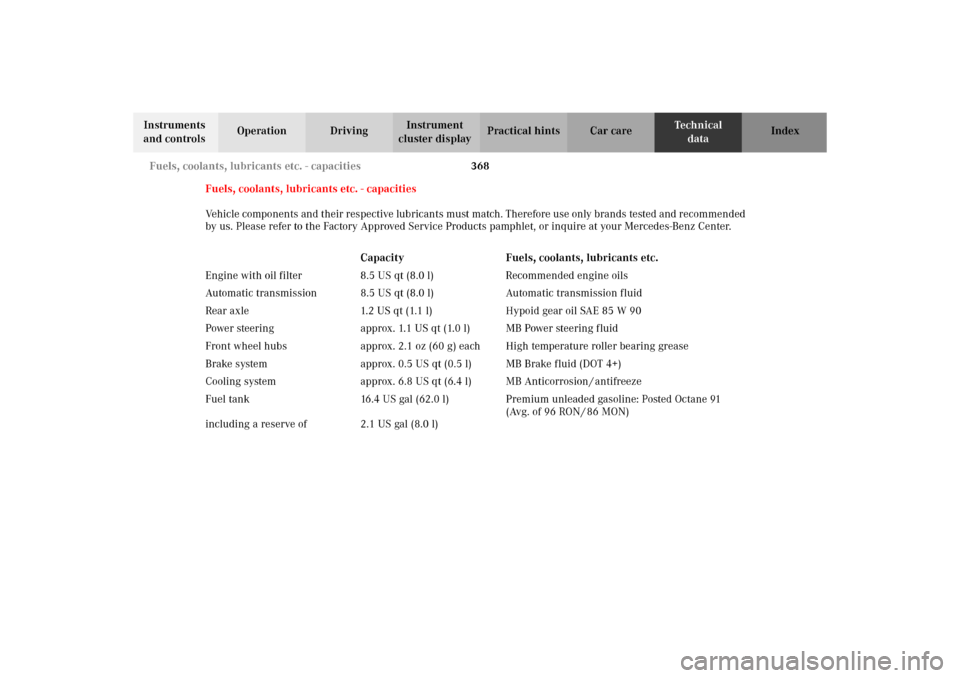
368 Fuels, coolants, lubricants etc. - capacities
Te ch n i c a l
data Instruments
and controlsOperation DrivingInstrument
cluster displayPractical hints Car care Index
Fuels, coolants, lubricants etc. - capacities
Vehicle components and their respective lubricants must match. Therefore use only brands tested and recommended
by us. Please refer to the Factory Approved Service Products pamphlet, or inquire at your Mercedes-Benz Center.
Capacity Fuels, coolants, lubricants etc.
Engine with oil filter 8.5 US qt (8.0 l) Recommended engine oils
Automatic transmission 8.5 US qt (8.0 l) Automatic transmission fluid
Rear axle 1.2 US qt (1.1 l) Hypoid gear oil SAE 85 W 90
Power steering approx. 1.1 US qt (1.0 l) MB Power steering fluid
Front wheel hubs approx. 2.1 oz (60 g) each High temperature roller bearing grease
Brake system approx. 0.5 US qt (0.5 l) MB Brake fluid (DOT 4+)
Cooling system approx. 6.8 US qt (6.4 l) MB Anticorrosion / antifreeze
Fuel tank
including a reserve of16.4 US gal (62.0 l)
2.1 US gal (8.0 l)Premium unleaded gasoline: Posted Octane 91
(Avg. of 96 RON / 86 MON)
S203.book Seite 368 Freitag, 19. Oktober 2001 1:25 13
Page 372 of 390
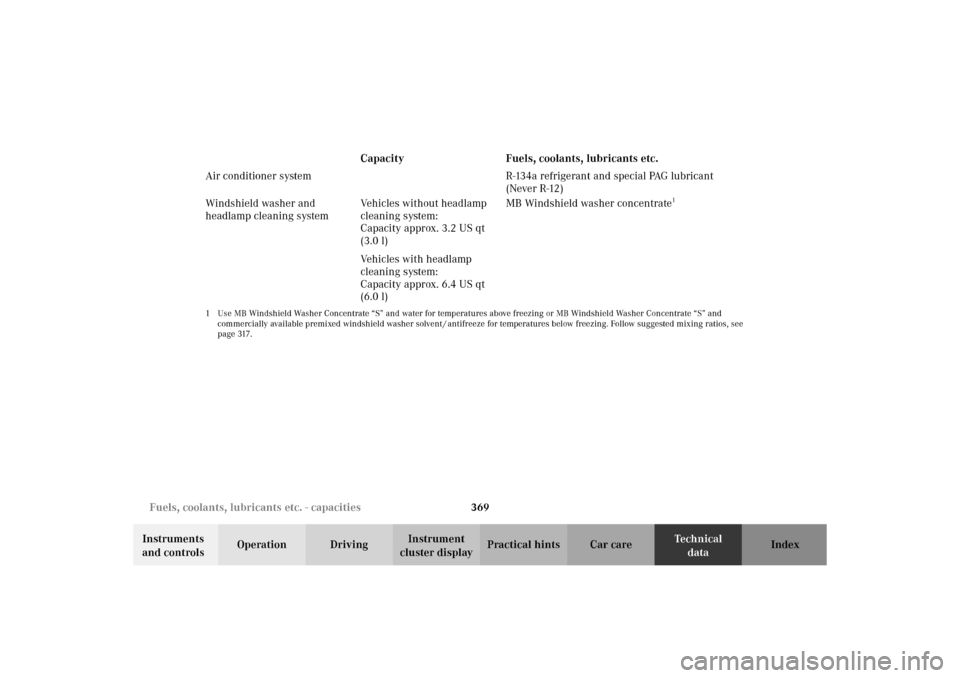
369 Fuels, coolants, lubricants etc. - capacities
Te ch n i c a l
data Instruments
and controlsOperation DrivingInstrument
cluster displayPractical hints Car care Index Air conditioner system R-134a refrigerant and special PAG lubricant
(Never R-12)
Windshield washer and
headlamp cleaning systemVehicles without headlamp
cleaning system:
Capacity approx. 3.2 US qt
(3.0 l)
Vehicles with headlamp
cleaning system:
Capacity approx. 6.4 US qt
(6.0 l)MB Windshield washer concentrate1
1 Use MB Windshield Washer Concentrate “S” and water for temperatures above freezing or MB Windshield Washer Concentrate “S” and
commercially available premixed windshield washer solvent / antifreeze for temperatures below freezing. Follow suggested mixing ratios, see
p a g e 317 .
Capacity Fuels, coolants, lubricants etc.
S203.book Seite 369 Freitag, 19. Oktober 2001 1:25 13
Page 373 of 390
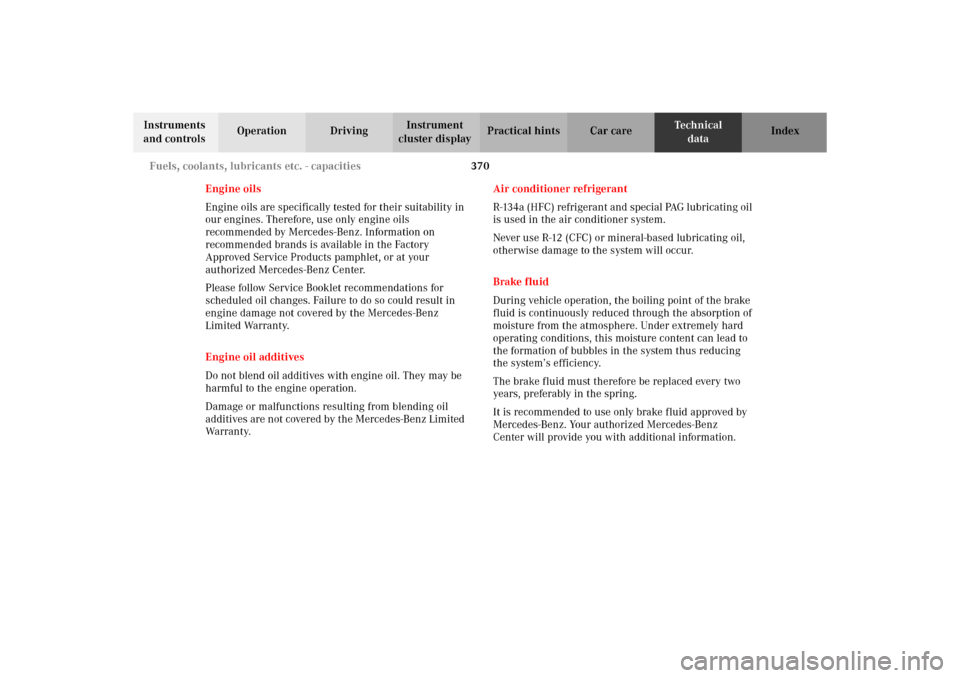
370 Fuels, coolants, lubricants etc. - capacities
Te ch n i c a l
data Instruments
and controlsOperation DrivingInstrument
cluster displayPractical hints Car care Index
Engine oils
Engine oils are specifically tested for their suitability in
our engines. Therefore, use only engine oils
recommended by Mercedes-Benz. Information on
recommended brands is available in the Factory
Approved Service Products pamphlet, or at your
authorized Mercedes-Benz Center.
Please follow Service Booklet recommendations for
scheduled oil changes. Failure to do so could result in
engine damage not covered by the Mercedes-Benz
Limited Warranty.
Engine oil additives
Do not blend oil additives with engine oil. They may be
harmful to the engine operation.
Damage or malfunctions resulting from blending oil
additives are not covered by the Mercedes-Benz Limited
Warranty.Air conditioner refrigerant
R-134a (HFC) refrigerant and special PAG lubricating oil
is used in the air conditioner system.
Never use R-12 (CFC) or mineral-based lubricating oil,
otherwise damage to the system will occur.
Brake fluid
During vehicle operation, the boiling point of the brake
fluid is continuously reduced through the absorption of
moisture from the atmosphere. Under extremely hard
operating conditions, this moisture content can lead to
the formation of bubbles in the system thus reducing
the system’s efficiency.
The brake fluid must therefore be replaced every two
years, preferably in the spring.
It is recommended to use only brake fluid approved by
Mercedes-Benz. Your authorized Mercedes-Benz
Center will provide you with additional information.
S203.book Seite 370 Freitag, 19. Oktober 2001 1:25 13
Page 374 of 390
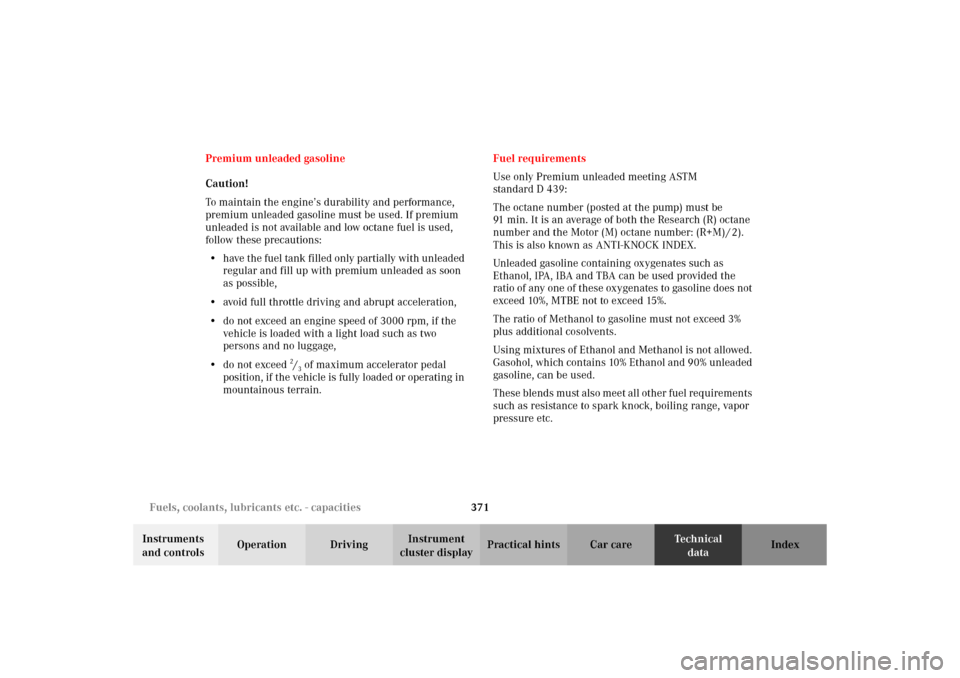
371 Fuels, coolants, lubricants etc. - capacities
Te ch n i c a l
data Instruments
and controlsOperation DrivingInstrument
cluster displayPractical hints Car care Index Premium unleaded gasoline
Caution!
To maintain the engine’s durability and performance,
premium unleaded gasoline must be used. If premium
unleaded is not available and low octane fuel is used,
follow these precautions:
•have the fuel tank filled only partially with unleaded
regular and fill up with premium unleaded as soon
as possible,
•avoid full throttle driving and abrupt acceleration,
•do not exceed an engine speed of 3000 rpm, if the
vehicle is loaded with a light load such as two
persons and no luggage,
•do not exceed
2/3 of maximum accelerator pedal
position, if the vehicle is fully loaded or operating in
mountainous terrain.Fuel requirements
Use only Premium unleaded meeting ASTM
standard D 439:
The octane number (posted at the pump) must be
91 min. It is an average of both the Research (R) octane
number and the Motor (M) octane number: (R+M) / 2).
This is also known as ANTI-KNOCK INDEX.
Unleaded gasoline containing oxygenates such as
Ethanol, IPA, IBA and TBA can be used provided the
ratio of any one of these oxygenates to gasoline does not
exceed 10%, MTBE not to exceed 15%.
The ratio of Methanol to gasoline must not exceed 3%
plus additional cosolvents.
Using mixtures of Ethanol and Methanol is not allowed.
Gasohol, which contains 10% Ethanol and 90% unleaded
gasoline, can be used.
These blends must also meet all other fuel requirements
such as resistance to spark knock, boiling range, vapor
pressure etc.
S203.book Seite 371 Freitag, 19. Oktober 2001 1:25 13
Page 375 of 390
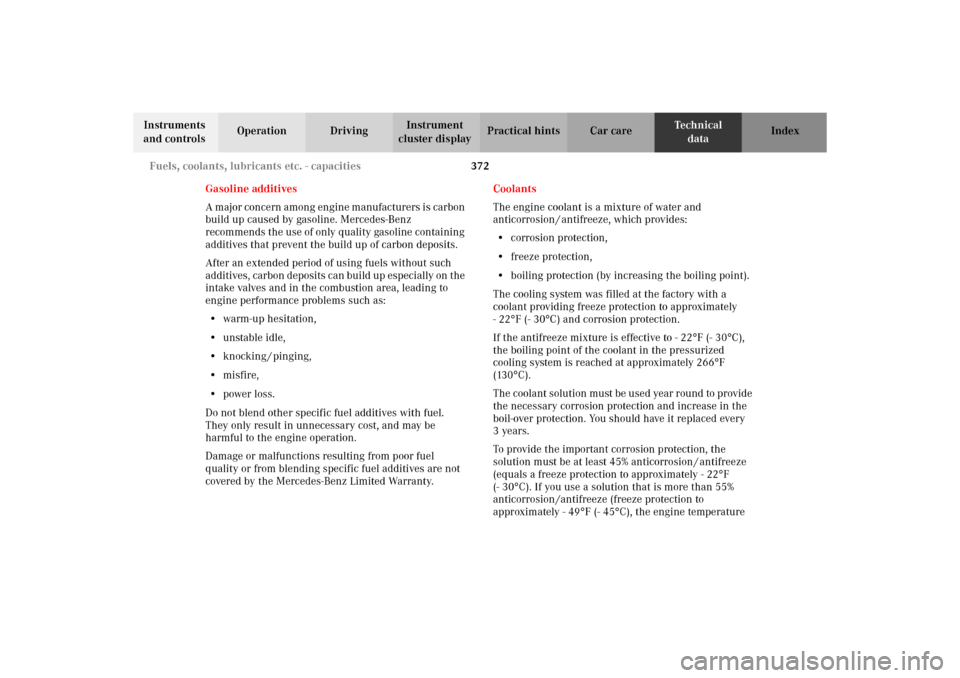
372 Fuels, coolants, lubricants etc. - capacities
Te ch n i c a l
data Instruments
and controlsOperation DrivingInstrument
cluster displayPractical hints Car care Index
Gasoline additives
A major concern among engine manufacturers is carbon
build up caused by gasoline. Mercedes-Benz
recommends the use of only quality gasoline containing
additives that prevent the build up of carbon deposits.
After an extended period of using fuels without such
ad ditives , car bon d ep osits c an build up esp ecially on t he
intake valves and in the combustion area, leading to
engine performance problems such as:
•warm-up hesitation,
•unstable idle,
•knocking / pinging,
•misfire,
•power loss.
Do not blend other specific fuel additives with fuel.
They only result in unnecessary cost, and may be
harmful to the engine operation.
Damage or malfunctions resulting from poor fuel
quality or from blending specific fuel additives are not
covered by the Mercedes-Benz Limited Warranty.Coolants
The engine coolant is a mixture of water and
anticorrosion / antifreeze, which provides:
•corrosion protection,
•freeze protection,
•boiling protection (by increasing the boiling point).
The cooling system was filled at the factory with a
coolant providing freeze protection to approximately
- 22
°F (- 30
°C) and corrosion protection.
If the antifreeze mixture is effective to - 22
°F (- 30
°C),
the boiling point of the coolant in the pressurized
cooling system is reached at approximately 266
°F
(130
°C).
The coolant solution must be used year round to provide
the necessary corrosion protection and increase in the
boil-over protection. You should have it replaced every
3years.
To provide the important corrosion protection, the
solution must be at least 45% anticorrosion / antifreeze
(equals a freeze protection to approximately - 22
°F
(- 30
°C). If you use a solution that is more than 55%
anticorrosion /antifreeze (freeze protection to
approximately - 49
°F (- 45
°C), the engine temperature
S203.book Seite 372 Freitag, 19. Oktober 2001 1:25 13
Page 376 of 390
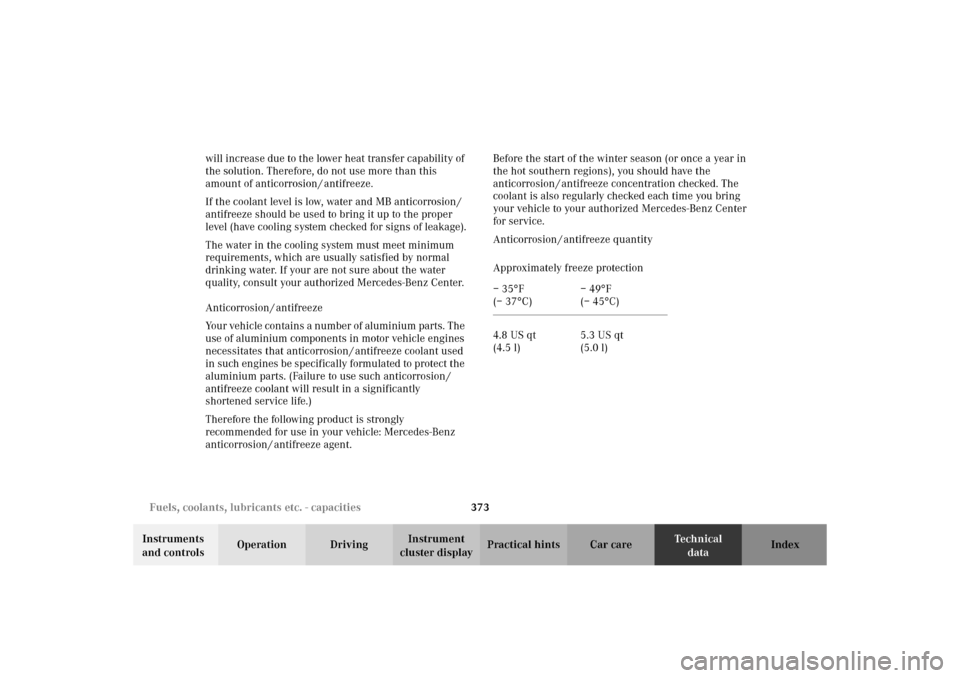
373 Fuels, coolants, lubricants etc. - capacities
Te ch n i c a l
data Instruments
and controlsOperation DrivingInstrument
cluster displayPractical hints Car care Index will increase due to the lower heat transfer capability of
the solution. Therefore, do not use more than this
amount of anticorrosion / antifreeze.
If the coolant level is low, water and MB anticorrosion /
antifreeze should be used to bring it up to the proper
level (have cooling system checked for signs of leakage).
The water in the cooling system must meet minimum
requirements, which are usually satisfied by normal
drinking water. If your are not sure about the water
quality, consult your authorized Mercedes-Benz Center.
Anticorrosion / antifreeze
Your vehic le con tain s a n umbe r o f aluminium parts. The
use of aluminium components in motor vehicle engines
necessitates that anticorrosion / antifreeze coolant used
in such engines be specifically formulated to protect the
aluminium parts. (Failure to use such anticorrosion /
antifreeze coolant will result in a significantly
shortened service life.)
Therefore the following product is strongly
recommended for use in your vehicle: Mercedes-Benz
anticorrosion / antifreeze agent.Before the start of the winter season (or once a year in
the hot southern regions), you should have the
anticorrosion / antifreeze concentration checked. The
coolant is also regularly checked each time you bring
your vehicle to your authorized Mercedes-Benz Center
for service.
Anticorrosion / antifreeze quantity
Approximately freeze protection
– 35
°F
(– 37°C)– 49
°F
(– 45°C)
4.8 US qt
(4.5 l)5.3 US qt
(5.0 l)
S203.book Seite 373 Freitag, 19. Oktober 2001 1:25 13
Page 377 of 390
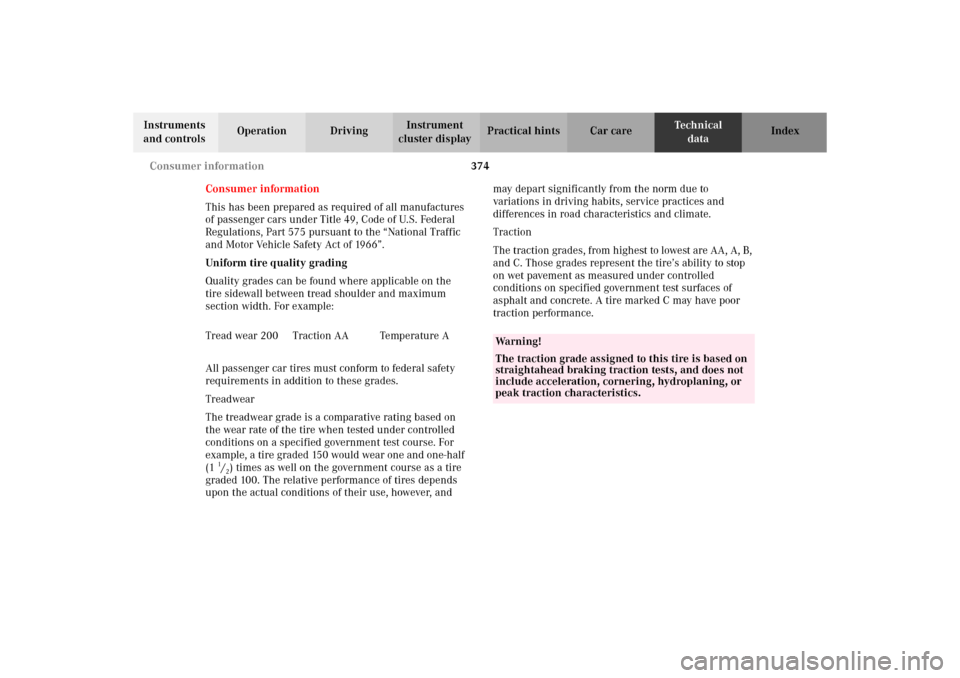
374 Consumer information
Te ch n i c a l
data Instruments
and controlsOperation DrivingInstrument
cluster displayPractical hints Car care Index
Consumer information
This has been prepared as required of all manufactures
of passenger cars under Title 49, Code of U.S. Federal
Regulations, Part 575 pursuant to the “National Traffic
and Motor Vehicle Safety Act of 1966”.
Uniform tire quality grading
Quality grades can be found where applicable on the
tire sidewall between tread shoulder and maximum
section width. For example:
All passenger car tires must conform to federal safety
requirements in addition to these grades.
Treadwear
The treadwear grade is a comparative rating based on
the wear rate of the tire when tested under controlled
conditions on a specified government test course. For
example, a tire graded 150 would wear one and one-half
(1
1/2) times as well on the government course as a tire
graded 100. The relative performance of tires depends
upon the actual conditions of their use, however, and may depart significantly from the norm due to
variations in driving habits, service practices and
differences in road characteristics and climate.
Traction
The traction grades, from highest to lowest are AA, A, B,
and C. Those grades represent the tire’s ability to stop
on wet pavement as measured under controlled
conditions on specified government test surfaces of
asphalt and concrete. A tire marked C may have poor
traction performance.
Tread wear 200 Traction AA Temperature A
Wa r n i n g !
The traction grade assigned to this tire is based on
straightahead braking traction tests, and does not
include acceleration, cornering, hydroplaning, or
peak traction characteristics.
S203.book Seite 374 Freitag, 19. Oktober 2001 1:25 13
Page 378 of 390
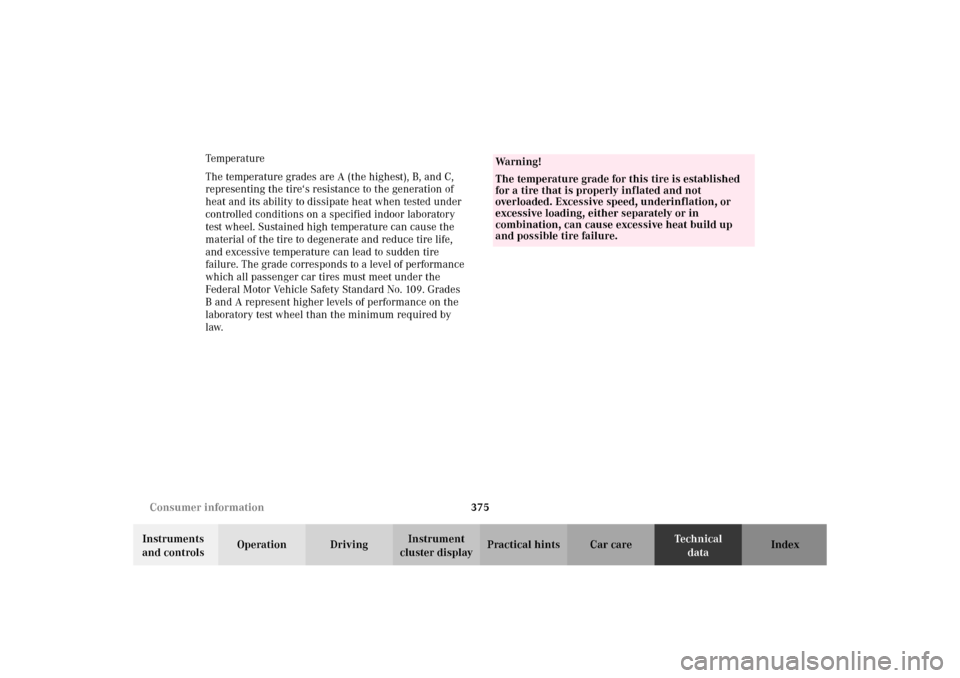
375 Consumer information
Te ch n i c a l
data Instruments
and controlsOperation DrivingInstrument
cluster displayPractical hints Car care Index Tempera t u re
The temperature grades are A (the highest), B, and C,
representing the tire‘s resistance to the generation of
heat and its ability to dissipate heat when tested under
controlled conditions on a specified indoor laboratory
test wheel. Sustained high temperature can cause the
material of the tire to degenerate and reduce tire life,
and excessive temperature can lead to sudden tire
failure. The grade corresponds to a level of performance
which all passenger car tires must meet under the
Federal Motor Vehicle Safety Standard No. 109. Grades
B and A represent higher levels of performance on the
laboratory test wheel than the minimum required by
law.
Wa r n i n g !
The temperature grade for this tire is established
for a tire that is properly inflated and not
overloaded. Excessive speed, underinflation, or
excessive loading, either separately or in
combination, can cause excessive heat build up
and possible tire failure.
S203.book Seite 375 Freitag, 19. Oktober 2001 1:25 13
Page 379 of 390
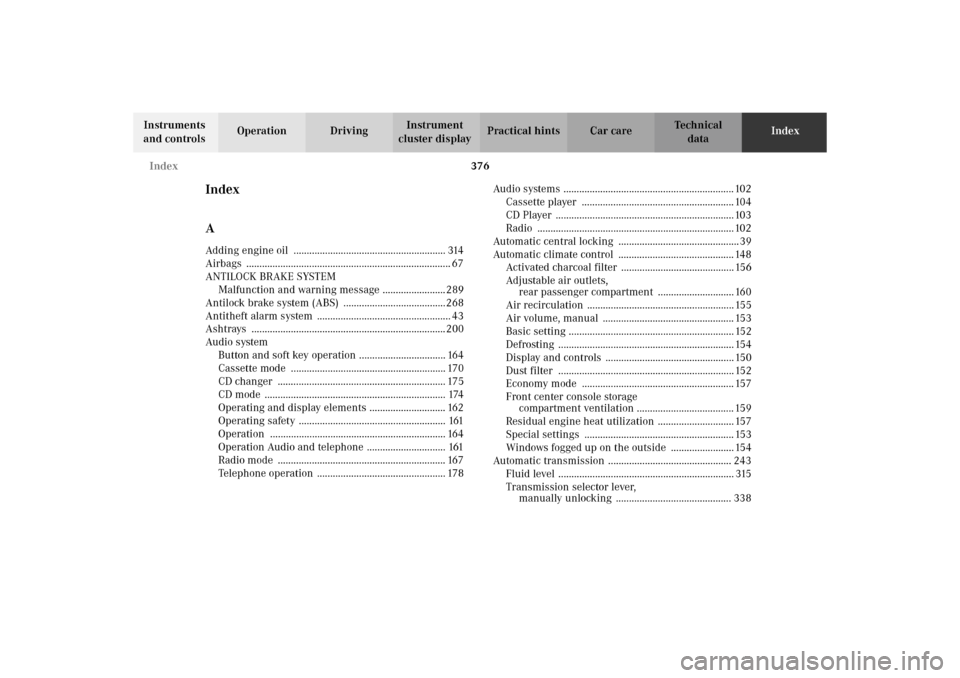
376 Index
Te ch n i c a l
data Instruments
and controlsOperation DrivingInstrument
cluster displayPractical hints Car careIndex
Index
AAdding engine oil .......................................................... 314
Airbags .............................................................................. 67
ANTILOCK BRAKE SYSTEM
Malfunction and warning message ........................ 289
Antilock brake system (ABS) .......................................268
Antitheft alarm system ................................................... 43
Ashtrays .......................................................................... 200
Audio system
Button and soft key operation ................................. 164
Cassette mode ........................................................... 170
CD changer ................................................................ 175
CD mode ..................................................................... 174
Operating and display elements ............................. 162
Operating safety ........................................................ 161
Operation ................................................................... 164
Operation Audio and telephone .............................. 161
Radio mode ................................................................ 167
Telephone operation ................................................. 178Audio systems ................................................................. 102
Cassette player .......................................................... 104
CD Player .................................................................... 103
Radio ........................................................................... 102
Automatic central locking .............................................. 39
Automatic climate control ............................................ 148
Activated charcoal filter ........................................... 156
Adjustable air outlets,
rear passenger compartment ............................. 160
Air recirculation ........................................................ 155
Air volume, manual .................................................. 153
Basic setting ............................................................... 152
Defrosting ................................................................... 154
Display and controls ................................................. 150
Dust filter ................................................................... 152
Economy mode .......................................................... 157
Front center console storage
compartment ventilation ..................................... 159
Residual engine heat utilization ............................. 157
Special settings ......................................................... 153
Windows fogged up on the outside ........................ 154
Automatic transmission ............................................... 243
Fluid level ................................................................... 315
Transmission selector lever,
manually unlocking ............................................ 338
S203.book Seite 376 Freitag, 19. Oktober 2001 1:25 13
Page 380 of 390
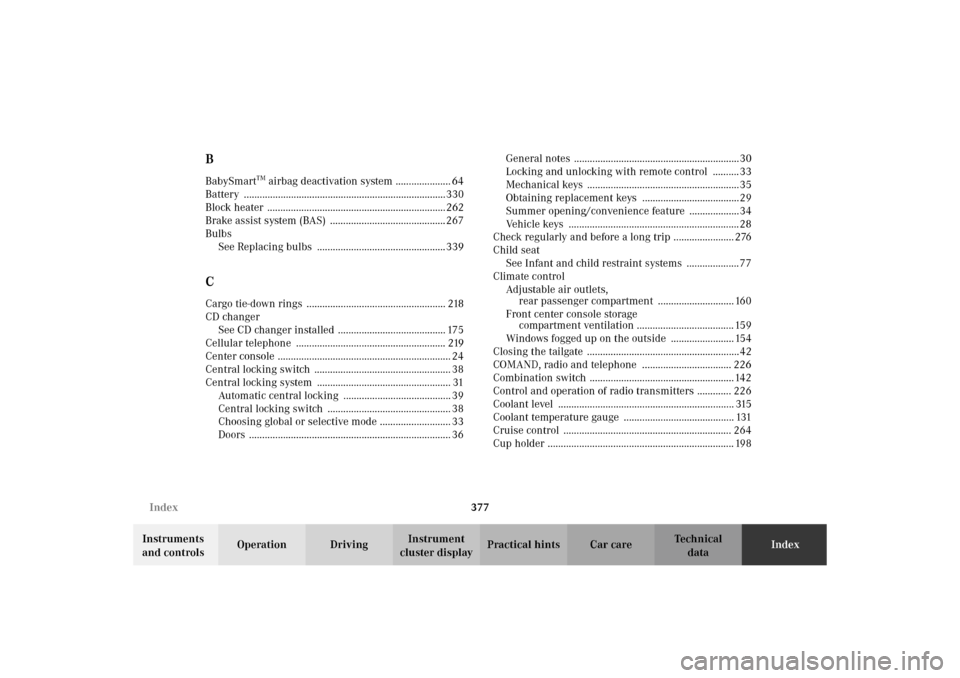
377 Index
Te ch n i c a l
data Instruments
and controlsOperation DrivingInstrument
cluster displayPractical hints Car careIndex
BBabySmart
TM airbag deactivation system ..................... 64
Battery .............................................................................330
Block heater .................................................................... 262
Brake assist system (BAS) ............................................ 267
Bulbs
See Replacing bulbs ................................................. 339
CCargo tie-down rings ..................................................... 218
CD changer
See CD changer installed ......................................... 175
Cellular telephone ......................................................... 219
Center console .................................................................. 24
Central locking switch .................................................... 38
Central locking system ................................................... 31
Automatic central locking ......................................... 39
Central locking switch ............................................... 38
Choosing global or selective mode ........................... 33
Doors ............................................................................. 36General notes ...............................................................30
Locking and unlocking with remote control .......... 33
Mechanical keys ..........................................................35
Obtaining replacement keys .....................................29
Summer opening/convenience feature ...................34
Vehicle keys ................................................................. 28
Check regularly and before a long trip ....................... 276
Child seat
See Infant and child restraint systems .................... 77
Climate control
Adjustable air outlets,
rear passenger compartment ............................. 160
Front center console storage
compartment ventilation ..................................... 159
Windows fogged up on the outside ........................ 154
Closing the tailgate ..........................................................42
COMAND, radio and telephone .................................. 226
Combination switch ....................................................... 142
Control and operation of radio transmitters ............. 226
Coolant level ................................................................... 315
Coolant temperature gauge .......................................... 131
Cruise control ................................................................ 264
Cup holder ....................................................................... 198
S203.book Seite 377 Freitag, 19. Oktober 2001 1:25 13